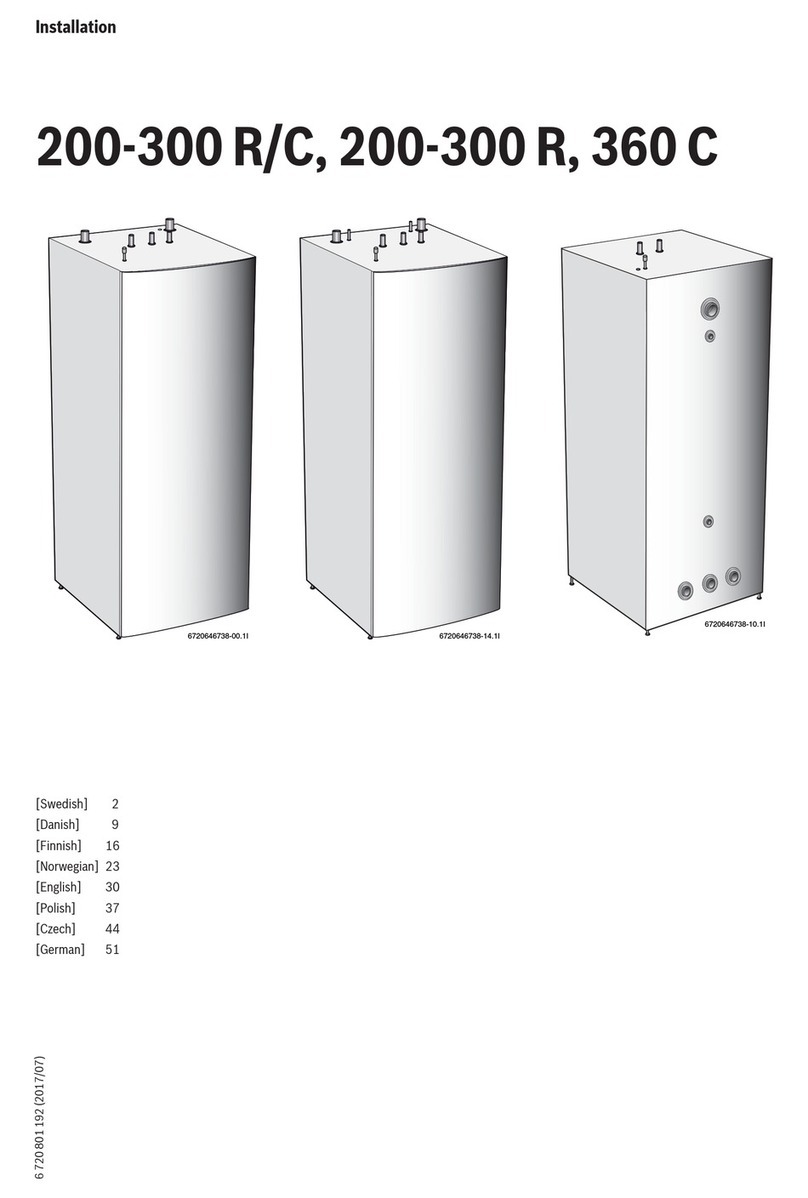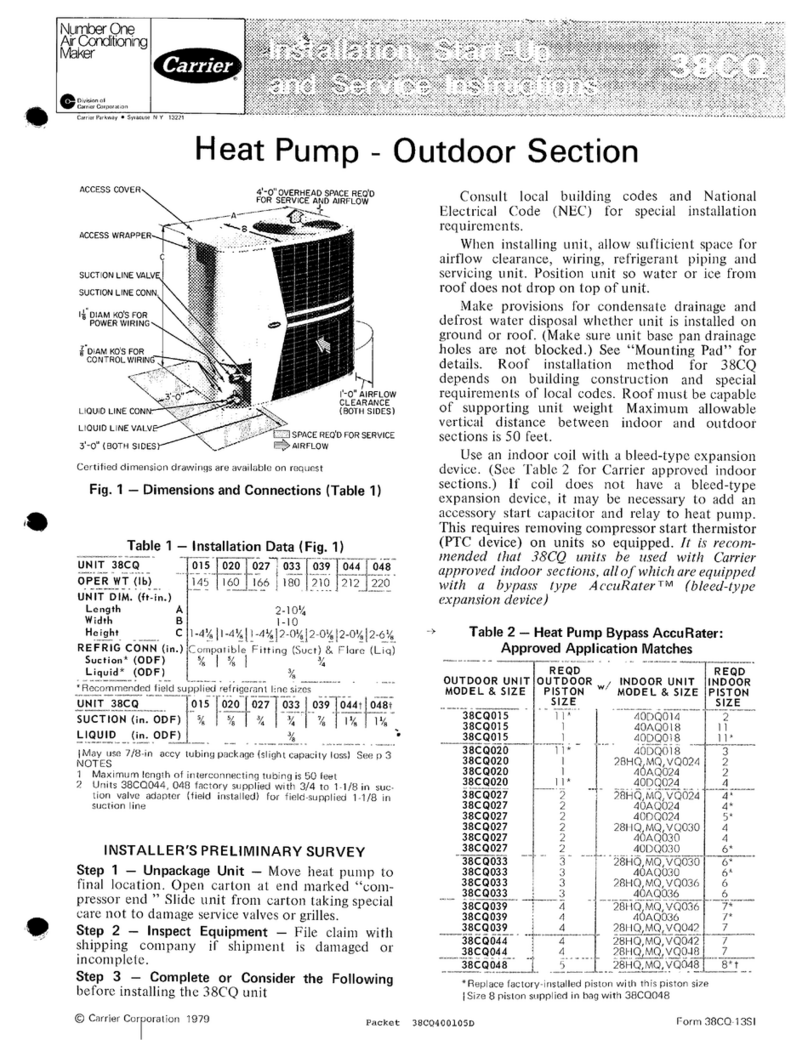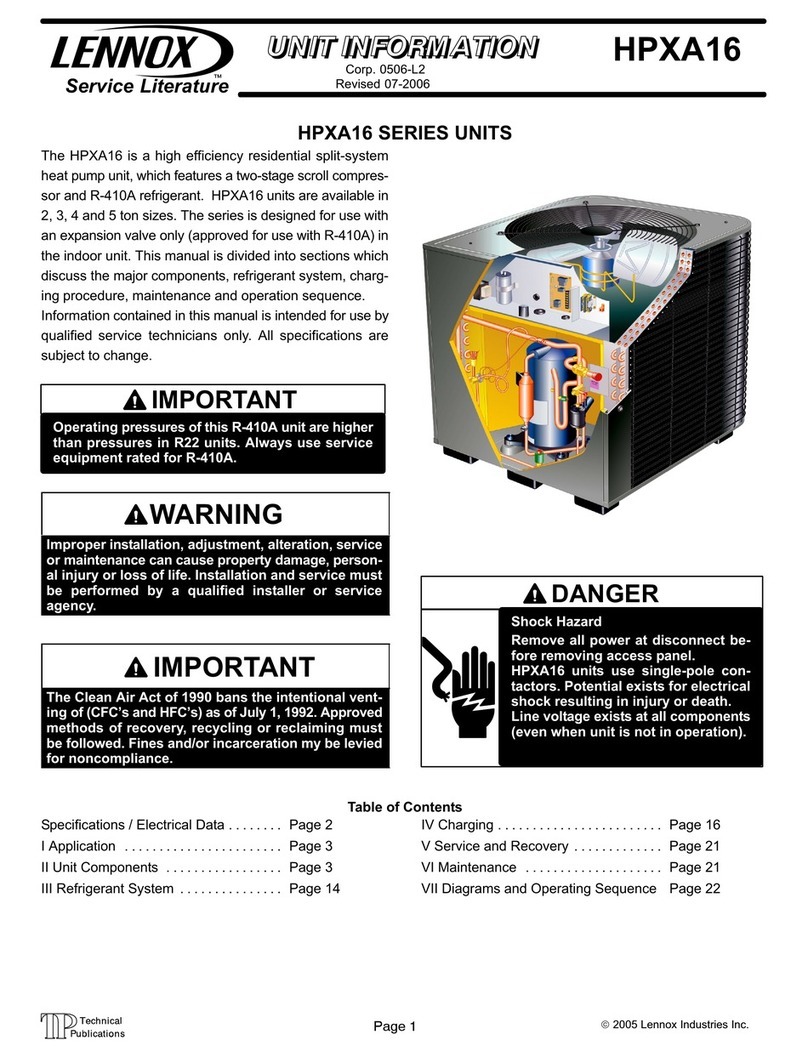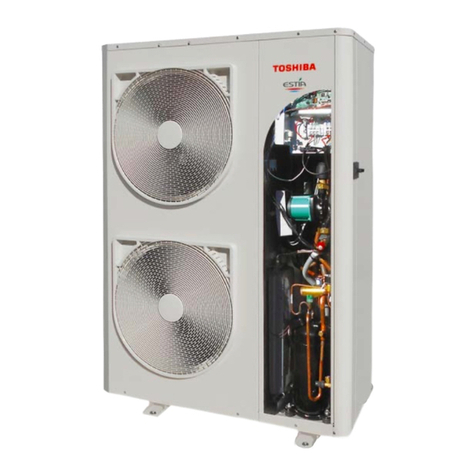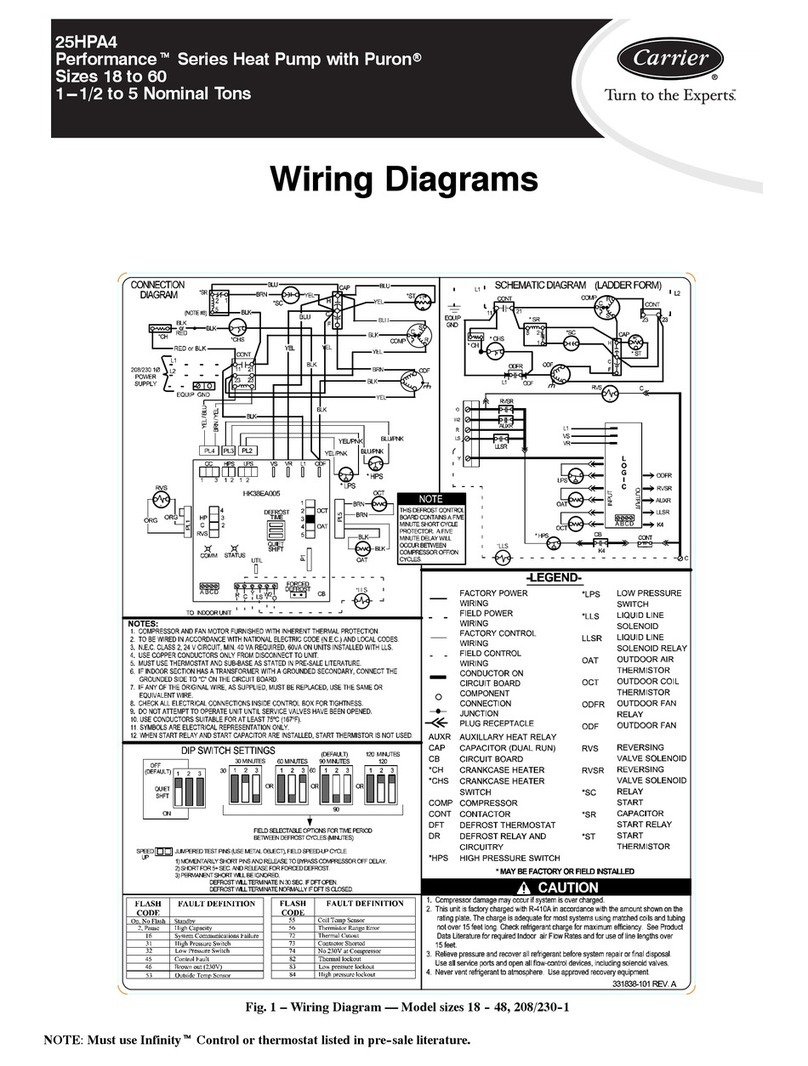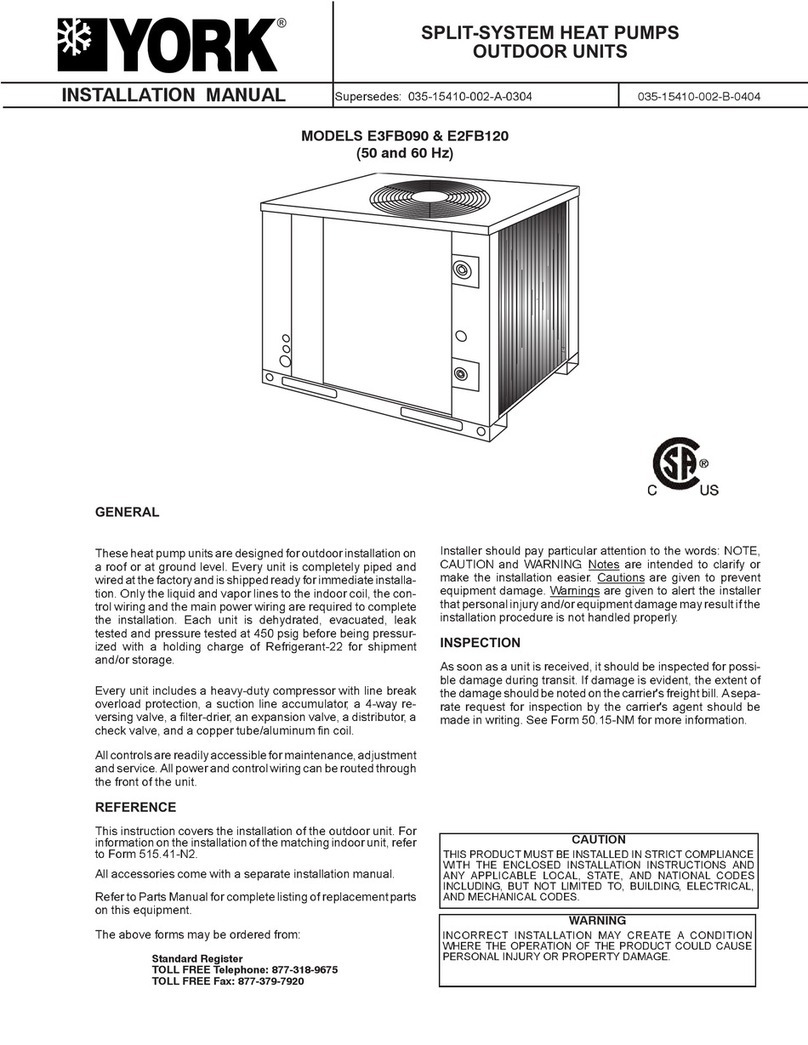GESTRA TK 23 User manual

Steam Trap for Large Condensate
Flowrates
TK 23
TK 24
Original Installation Instructions
819309-01

Contents
Foreword ............................................................................................................................................3
Availability.............................................................................................................................................3
Formatting features in the document ......................................................................................................3
Safety..................................................................................................................................................3
Use for the intended purpose .................................................................................................................3
Basic safety notes .................................................................................................................................4
Information on property damage or malfunctions .....................................................................................4
Qualification of personnel.......................................................................................................................4
Protective gear......................................................................................................................................5
Typographic features of warning notes....................................................................................................5
Formatting features for warnings of property damage ..............................................................................5
Description .........................................................................................................................................5
Scope of supply and equipment specification ..........................................................................................5
Task and function..................................................................................................................................9
Storing and transporting the equipment.........................................................................................11
Storing the equipment .........................................................................................................................11
Transporting the equipment .................................................................................................................11
Mounting and connecting the equipment.......................................................................................11
Preparing installation ...........................................................................................................................11
Connecting the equipment ...................................................................................................................12
Adapting settings.............................................................................................................................13
Special adjustments for equipment with DN 50 .....................................................................................14
Special adjustments for equipment with DN 65 .....................................................................................24
Operation ..........................................................................................................................................34
After operation .................................................................................................................................34
Removing external dirt deposits............................................................................................................34
Maintaining the equipment...................................................................................................................34
Servicing the equipment and installing spare parts ................................................................................42
Troubleshooting ...............................................................................................................................49
Putting the equipment out of operation..........................................................................................52
Removing harmful substances..............................................................................................................52
Removing the equipment .....................................................................................................................52
Re-using equipment after storage.........................................................................................................53
Disposing of the equipment..................................................................................................................53
Technical data..................................................................................................................................54
Dimensions and weights ......................................................................................................................54
Pressure & temperature ratings............................................................................................................55
Capacity Charts...................................................................................................................................56
Lift-Restriction Charts ..........................................................................................................................58
Manufacturer's declaration.............................................................................................................61

3
Foreword
This installation & operating manual will help you
use the following types of equipment safely and
efficiently for their intended purpose.
TK 23
TK 24
These steam traps will be called equipment in this
document.
This installation & operating manual is intended for
anyone commissioning, using, operating, servicing,
cleaning or disposing of this equipment and, in
particular, for professional after-sales service
technicians, qualified personnel and authorised and
trained staff.
All of these persons must read and understand the
content of this installation & operating manual.
Following the instructions given in this installation &
operating manual helps avoiding danger and
increases the reliability and service life of the
equipment. Please note that in addition to the
instructions given in this installation & operating
manual you must also observe all locally applicable
rules and regulations concerning the prevention of
accidents as well as approved safety guidelines for
good professional practice.
Availability
Keep this installation & operating manual together
with the plant documentation for future reference.
Make sure that this installation & operating manual
is available to the operator.
The installation & operating manual is part of the
equipment. Please hand over this installation &
operating manual when selling the equipment or
passing it on.
Formatting features in the
document
Certain text elements of this installation & operating
manual feature a specific typographic design. You
can easily distinguish the following text elements:
Standard text
Cross-reference
Listing
Sub-items in listings
Steps for action.
Here you will find additional useful
information and tips serving to
assist you
in using the equipment to its fullest
potential.
Safety
Use for the intended purpose
The following thermostatic/thermodynamic steam
traps are installed in steam lines:
TK 23
TK 24
The equipment is designed for discharging large
condensate flowrates that are produced
continuously and for air-venting pipelines.
The equipment must only be used within the
allowable pressure and temperature limits and only
if the chemical and corrosive influences on the
equipment are taken into account.
Do not expose the control membrane of the
membrane regulator capsule to superheat
conditions above 5 °C.
Correct use includes compliance with the
instructions given in this installation & operating
manual, in particular obedience to all safety
instructions.
Any other use of the equipment is considered to be
improper.

4
Note that the equipment is also used incorrectly if
the materials of the equipment are not suitable for
the fluid.
Basic safety notes
Risk of severe injuries
The equipment is under pressure during
operation and may be hot. Before carrying out
any work on the equipment make sure that the
following requirements are met:
The pipes must be depressurized (0 bar).
The fluid must be completely removed from
the pipes and the equipment.
During work on the equipment the
installation must be switched off and
protected against unauthorised or
unintended activation.
The pipes and the equipment must have
cooled down to room temperature (approx.
20 °C).
If the equipment is used in contaminated areas
there is a risk of severe injuries or death caused
by harmful substances in or on the equipment.
Before working on the equipment make sure
that it is completely decontaminated. Always
wear the protective clothing prescribed for
contaminated areas when working on the
equipment.
The equipment must only be used with fluids
that do not attack the material and the gaskets
and sealings of the equipment. Otherwise leaks
may occur and hot or toxic fluid could escape.
The equipment and its component parts must
only be mounted or removed by qualified
personnel. A qualified person must be
acquainted with and experienced in the
following:
Making pipe connections.
Selecting suitable lifting gear and
understanding the rules for its safe use.
Working with dangerous (contaminated, hot
or pressurized) fluids.
Risk of minor injuries
Sharp edges on internals present the danger of
cuts to hands. Always wear industrial gloves
when servicing the equipment.
If the support of the equipment during
installation is insufficient the equipment might
fall down, thereby causing bruises or injuries.
Make sure the equipment is safely held in place
during installation and cannot fall down. Wear
protective safety footwear.
Information on property damage
or malfunctions
Malfunctions will occur if the equipment is
installed in a wrong position or with the flow
arrow pointing in the opposite direction of the
fluid flow. This may result in damage to the
equipment or the installation. Make sure that
the flow arrow on the equipment body matches
the indicated direction of the fluid flow in the
pipe.
If the material is unsuitable for the fluid,
increased wear may occur and fluid may
escape. Make sure that the material is suitable
for the fluid used in your installation.
Qualification of personnel
A qualified person must be acquainted with and
experienced in the following:
the pertinent on-site rules and regulations for
preventing fire and explosions as well as
industrial safety regulations
working on pressure equipment
making pipe connections
working with dangerous (hot or pressurized)
fluids
lifting and transporting loads
observing all notes and instructions in this
installation & operating manual and the
applicable documents

5
Protective gear
The required protective gear depends on the types
of fluid used and the regulations on site. For more
information on suitable safety clothing and safety
gear refer to the safety data sheet of the fluid in
question.
Protective gear comprises the following items:
protective helmet
work boots
industrial leather gloves
Typographic features of warning
notes
DANGER
Notes with the heading DANGER warn
against imminent dangerous situations that
can lead to death or serious injuries.
WARNING
N
otes with the heading WARNING warn
against possibly dangerous situations that
could lead to death or serious injuries.
CAUTION
Notes with the heading CAUTION warn
against dangerous situations that could
lead to minor or moderate injuries.
Formatting features for warnings
of property damage
Attention!
This information warns of a situation
leading to property damage.
Description
Scope of supply and equipment
specification
Scope of supply
Our equipment is delivered packed and ready for
assembly.
Equipment specification
TK 23 and TK 24 are operationally identical but
differ in their limiting conditions and materials of
construction.
Equipment of type TK 23 is rated for nominal
pressure PN16, TK 24 for nominal pressure PN 25.
Equipment of various sizes differ in the following
Equipment with DN 50 is provided with one
adjustment screw in the cover. The adjustment
screw can be used to set either a miniumum
flowrate or a maximum flowrate.
This equipment type features three membrane
regulator capsules.
Equipment from DN 65 onwards has two covers,
each one provided with one adjustment screw.
With the adjustment screw in the top cover you
can set the maximum flowrate. With the
adjustment screw in the bottom cover you can
set the minimum flowrate.
This equipment type features four membrane
regulator capsules.
The following membrane regulator capsules are
available:
Type 5H2 (standard)
Type 0H2 (for differential pressures below 1 bar
and operating pressures up to 5 bar)

6
Explosion view of equipment DN 50
Item
no.
Designation
1
Cap nut
2
Hexagon-head cap bolts (4 pcs.)
3
Cover
4
Regulator unit
5
Body
Item
no.
Designation
6
Direction of flow arrow
7
Type specification on body (instead of
name plate)
8
Thermostatic (membrane regulator)
capsule (3 pcs.)
9
Adjustment screw
10
Sealing plug

7
Explosion view of equipment DN 65 - 100
Item
no.
Designation
1
Cap nut (2 pcs.)
2
Hexagon-head cap bolts (6 pcs. per
cover)
3
Cover (2 pcs.)
4
Regulator unit
5
Body
6
Direction of flow arrow
Item
no.
Designation
7
Type specification on body (instead of
name plate)
8 Thermostatic (membrane regulator)
capsule (4 pcs.)
10
Sealing plug (2 pcs.)
11
Adjustment screw for maximum flowrate
12
Adjustment screw for minimum flowrate
(leak passage)

8
Markings on the membrane regulator capsule
The following membrane regulator capsules are
available:
Type 5H2 (standard)
Type 0H2 (for differential pressures below 1 bar
and operating pressures up to 5 bar)
Item no.
Description
13
Code number for type
14
Code letter for opening temperature
15
Code number for capacity
16
Manufacturing code
End connections
The equipment is available with the following end
connections:
Flanges
Name plate
Instead of a nameplate the following items are
specified directly on the body:
Manufacturer
Type designation
Nominal size
Pressure rating
Material
CE marking
Direction of flow
Manufacturing date (quarter/year)
Application of European Directives
Pressure Equipment Directive
The equipment conforms to this directive (see
"Manufacturer's Declaration" section) and can be
used for the following media:
Fluids of group 2
ATEX Directive
The equipment does not have its own potential
ignition source and is not subject to this directive
(see "Manufacturer's Declaration" section).
When installed, static electricity may arise between
the equipment and the connected system.
When used in potentially explosive atmospheres,
the plant manufacturer or plant operator is
responsible for discharging or preventing possible
static charge.
If it is possible for medium to escape, e.g. through
actuating mechanisms or leaks in threaded joints,
the plant manufacturer or plant operator must take
this into consideration when dividing the area into
zones.

9
Task and function
Purpose
The equipment is designed for discharging large
condensate flowrates that are produced
continuously and for air-venting pipelines.
The equipment opens and closes as a function of
the membrane regulator (thermostatic capsules)
immediately below the pressure-dependent
saturation temperature.
At start-up and during operation the equipment
automatically vents non-condensable gases.
Function (equipment with DN 50)
The membrane regulator capsules and the
upstream pressure of the condensate control the
discharge of condensate.
If undercooled or cold condensate, or air or other
incondensable gases are present, the membrane
regulator capsules are in the open position.
The pressure in the chamber (18) drops below the
upstream pressure and, as a consequence, the
regulator unit is lifted and the valve (20) opens.
The condensate or the gas is discharged.
A small part of the fluid ("leak passage") flows
through the regulator unit with the membrane
regulator capsules. This partial flow enters the
chamber through the annular slot (17) and flows
through the regulator unit and the cone (19) before
it is discharged.
This ensures that the membrane regulator capsules
always have the same temperature as the fluid.
Immediately before the boiling temperature of water
is reached the membrane regulator capsules are
back in the closed position.
The partial flow can no longer drain. Inside the
chamber pressure builts up until it reaches the
upstream pressure of the fluid and the valve is
closed.
The lift plate (21) prevents the steam trap from
opening and closing abruptly.

10
Function (equipment with DN 65 - 100))
The membrane regulator capsules and the
upstream pressure of the condensate control the
discharge of condensate.
If undercooled or cold condensate, or air or other
incondensable gases are present, the membrane
regulator capsules are in the open position.
The pressure in the chamber (18) increases until it
reaches upstream pressure. As a result the
regulator unit is lifted, the valve (20) opens and the
condensate or gas drains.
A small part of the fluid ("leak passage") flows
through the regulator unit with the membrane
regulator capsules. This partial flow enters the valve
body and the tube (24), flows into the chamber and
leaves through the annular slot (17) and the cone
(19).
This ensures that the membrane regulator capsules
always have the same temperature as the fluid.
Immediately before the boiling temperature of water
is reached the membrane regulator capsules are
back in the closed position.
The annular slot causes the pressure in the
chamber to drop and,consequently, the valve
closes.
The dampening plate (22) and the chamber (23)
prevent the steam trap from opening and closing
abruptly.
Manual setting
In addition to the automatic opening and closing
process you can also adjust the valve opening
manually.
Equipment with DN 50 has only one adjustment
screw. With this equipment you can only adjust
either a maximum or a minimum flowrate.
Equipment from DN 65 onwards is provided with
two adjustment screws. Use the adjustment screw
on the top cover to regulate the maximum flowrate.
Use the adjustment screw on the bottom cover to
regulate the minimum flowrate.

11
Storing and transporting the
equipment
Attention!
Equipment can be damaged if stored or
transported improperly.
Close all openings with the sealing
plugs or covers supplied with the
equipment or use similar sealing
covers.
Protect the equipment against
moisture and corrosive atmospheres.
Please contact the manufacturer if the
specified transport and/or storage
requirements cannot be met.
Storing the equipment
Please observe the following items when storing
the equipment:
Do not store the equipment for more than 12
months.
Use the supplied sealing plugs or other suitable
seal caps in order to seal off all openings of the
equipment.
Protect the sealing surfaces and contact areas
against mechanical damage.
Protect the equipment and all components
against hard shocks and impacts.
Store the equipment only in closed rooms that
meet the following environmental conditions:
Air humidity below 50 %, not condensing
Indoor air: clean, salt-free and non-corrosive
Temperature 5–40 °C.
Make sure that all these requirements are
always met when storing the equipment.
Please contact the manufacturer if you cannot
comply with the recommended storage
conditions.
Transporting the equipment
Meet the requirements for storage also when
transporting the equipment.
Prior to transport seal off connections with
sealing plugs.
If you do not have the sealing plugs
supplied with the equipment us
e
appropriate seal caps to seal off the
connections.
For short distances (only a few metres) you can
transport the equipment unpacked.
When transporting the equipment over larger
distances use the original packaging.
If you do not have the original packaging use a
box that protects the equipment adequately
against corrosion and physical damage.
For a short period of time the equipment
may be transported even if the
temperature is below 0
°C, provided that
the equipment is completely empty and
dry.
Mounting and connecting the
equipment
Preparing installation
Take the equipment out of the transport
packaging.
Check the equipment for transport damage.
Contact the manufacturer if you detect any kind
of shipping damage.
When supplied by the factory, the connections may
be sealed off with sealing plugs.
Remove sealing plugs before mounting the
equipment.
Keep the sealing plugs and the packing for
further use.

12
DANGER
Personnel working on pipes are exposed to
safety risks and may suffer severe injuries,
poisoning or even loss of life.
Make sure that no hot or hazardous
fluid is in the equipment or the pipes.
Make sure that the pipes upstream
and downstream of the equipmen
t are
depressurised.
Make sure that the installation is
switched off and protected against
unauthorised or unintended activation.
Make sure that the equipment and the
pipes have cooled down to room
temperatures.
Wear protective clothing that is
suitable f
or the fluid and, if necessary,
wear protective gear.
For more information on suitable protective clothing
and safety gear refer to the safety data sheet of the
fluid in question.
Drain pipes until they are empty.
Switch the installation off and protect it against
unauthorised or unintended re-activation.
Connecting the equipment
DANGE
R
Incorrectly connected equipment can
cause fatal accidents or severe injuries.
Make sure that only qualified skilled
personnel connect the equipment to
pipes.
Make sure that the flow arrow on the
equipment body matches the direction
of flow in the pipe.
Specialist personnel must be highly qualified and
fully experienced in making pipe connections for the
respective type of end connection.
Attention!
Equipment will be damaged if the end
connections are undersized.
Make sure that the connections are
strong and rigid enough to support the
weight of the equipment and to
withstand the force
s that occur during
operation.
To allow easy access for routine servicing and
exchanging components observe the indicated
withdrawal distances and allow for clearances to
adjacent installation parts.
For more information see chapter
"Dimensions and
weights
" on page 54.
Make sure that the pipe system of the plant is
clean.
The equipment can be installed in any position.
For best protection against dirt install the
equipment preferably with the valve pointing
upwards.
Make sure that the equipment is free from
foreign matter.
Mount the equipment in the desired installation
position.
Make sure that the equipment is safely mounted
and that all connections are made correctly.
Attention!
Malfunctions may occur if the equipment
or condensate line is insulated.
Make sure that the heat generated by
the equipment or the condensate line
is dissipated.

13
Adapting settings
To guarantee a rapid response to temperature
changes, the membrane regulator capsules are
permanently exposed to defined partial flow of the
fluid (= minimium flowrate, so-called "leak
passage").
The following default partial flow settings are
adjusted at our factory:
Equipment with DN 50: 2 % of the maximum
flowrate
Equipment with DN 65 - 80: 1.5% of the
maximum flowrate
Equipment with DN 100: 1% of the maximum
flowrate
With factory setting the equipment discharges the
quantities given in the capacity charts on page 56.
To custom fit the steam trap to the individual
operating conditions of your installation you can
adjust the flowrate by limiting the valve travel ("lift
restriction") for the open or closed position.
Equipment with DN 50 is provided with only one
adjustment screw. With this equipment you can
only adjust either a maximum or a minimum
flowrate ("leak passage").
Equipment from DN 65 onwards is provided with
two adjustment screws. Use the adjustment screw
on the top cover to regulate the maximum flowrate.
Use the adjustment screw on the bottom cover to
regulate the minimum flowrate.
DANGER
Personnel working on pipes are exposed to
safety risks and may suffer severe injuries,
poisoning or even loss of life.
Make sure that no hot or hazardous
fluid is in the equipment or the pipes.
Make sure that the pipes upstream
and downstream of the equipment are
depressurised.
Make sure that the installation is
switched off and protected against
unauthorised or unintended activation.
Make sure that the equipment and the
pipes have cooled down to room
temperatures.
Wear protective clothing that is
suitable for the fluid and, if necessary,
wear protective gear.
For more information on suitable protective clothing
and safety gear refer to the safety data sheet of the
fluid in question.
For work on the equipment you will need the
following tools:
Torque spanner (US: wrench) 4-40 Nm
Torque spanner (US: wrench) 20-120 Nm
2 Spanners A. F. 8 mm
2 Spanners A. F. 19 mm (TK 23) or 24 mm (TK
24)
Screwdriver 6 mm
Screwdriver 10 mm

14
Attention!
Equipment may leak if the gasket is
damaged.
Replace all gaskets that you loosen
during your work.
Use only new gaskets of the same
type.
When working on the equipment you have to loosen
several screws. Loosening a screw may impair the
associated gasket. Therefore always replace the
gasket with a new one of the same type.
For more information on the required gasket types
refer to section "
Servicing the equipment and
installing spare parts
" from page 42 onwards.
Special adjustments for
equipment with DN 50
Equipment with DN 50 has only one adjustment
screw. With this equipment you can only adjust
either a maximum or a minimum flowrate ("leak
passage").
If the minimum flowrate is set to zero the
equipment gives steam-tight shut-off.
Limiting the maximum flowrate
To ensure that the equipment discharges
condensate as continuously as possible you have to
reduce the maximum flowrate.
To do so you must limit the valve travel in the
opening direction.
Attention!
Malfunctions due to banking
-up of
condensate.
Limiting the maximum
flowrate changes
the factory
-set leak passage ("partial
flow"). The equipment closes as soon as
steam arrives. Note that the
responsiveness of the membrane regulator
is reduced due to the lack of a partial flow.
As a result condensate may bank up.
Make sure that the process in the
higher-level plant system is not
impaired by banking-up of
condensate.
To ascertain the required number of turns of the
adjustment screw proceed as follows:
Determine the ratio of the desired maximum
flowrate to the flowrate set at our factory.
Refer to the lift restriction chart to ascertain the
number of turns of the adjustment screw that
corresponds to this ratio.
The capacity charts are shown in section
"Capacity
Charts
" on page 56.
The lift restriction charts are shown in section "
Lift-
Restriction Charts
" from page 58 onwards.

15
Example
The charts shown in this example are reduced in
size. Use the charts in original size to ascertain the
required setting.
A max. flowrate of 6.75 t/h for hot fluid and a
differential pressure of 0.85 bar is desired.
Using the capacity chart for hot fluid you can
determine that for a differential pressure of
0.85 bar the factory-set flowrate is 9 t/h.
This yields a ratio of (6.75 × 100)/9 = 75%.
According to the lift-restriction chart a ratio of 75 %
(line "A") corresponds to one turn to the right of the
adjustment screw.
Make sure that the equipment is depressurized,
cooled down to room temperature and free from
fluid.
To reduce the pressure through the bore in the
cover slowly loosen the sealing plug by two
turns (10).
Remove the cap nut (1).
Remove the outer gasket (26) from the
adjustment screw.
Remove the hexagon nut (25).
Remove the inner gasket (26) from the
adjustment screw.
Screw in the adjustment screw (9) until it hits
the stop.

16
Remove the sealing plug (10).
Take the gasket (27) out of the body.
Insert a screwdriver through the bore for the
sealing plug and push down the lift plate (21).
Loosen the adjustment screw (9) until the lift
plate starts to lift.
To reduce the maximum flowrate tighten the
adjustment screw by the number of turns
specified in the chart.
Attention!
Equipment may leak if the gasket is
damaged.
Replace all gaskets that you loosen
during your work.
Use only new gaskets of the same
type.
Put the new inner gasket (26) onto the
adjustment screw.
Put the hexagon nut (25) onto the adjustment
screw (9).
Make sure that the adjustment screw cannot
rotate.
For this purpose you can for example push the tip
of a screwdriver into the slot of the adjustment
screw.
Tighten the hexagon nut (25) with a torque of
30 Nm.
Put the new outer gasket (26) onto the
adjustment screw.
Screw the cap nut (1) onto the adjustment
screw.
Tighten the cap nut with a torque of 30 Nm.
Insert the new gasket (27) into the bore of the
sealing plug.
Put the sealing plug (10) into the bore.
The torque for the sealing plug depends on the
equipment type.
Equipment of type TK 23 requires a torque of
30 Nm.
Equipment of type TK 24 requires a torque of
40 Nm.
Fasten the sealing plug with the specified
torque.

17
Adjusting a minimum flowrate
To adjust a minimum flowrate (partial flow, "leak
passage") change the valve travel in the closing
direction.
Before changing the settings determine the
required turns as follows:
To ascertain the required number of turns of the
adjustment screw proceed as follows:
Determine the ratio of the desired minimum
flowrate to the flowrate set at our factory.
Refer to the lift restriction chart to ascertain the
number of turns of the adjustment screw that
corresponds to this ratio.
The capacity charts are shown in section
"Capacity
Charts
" on page 56.
The lift restriction charts are shown in section "
Lift-
Restriction Charts
" from page 58 onwards.
Example
The charts shown in this example are reduced in
size. Use the charts in original size to ascertain the
required setting.
A minimum flowrate of 0.9 t/h for hot fluid and a
differential pressure of 0.85 bar is desired.
Using the capacity chart for hot fluid you can
determine that for a differential pressure of
0.85 bar the factory-set flowrate is 9 t/h.
This yields a ratio of (0.9 × 100)/9 = 10%.
According to the lift-restriction chart a ratio of 10%
(line "B") corresponds to ¾ turn to the left of the
adjustment screw.

18
Make sure that the equipment is depressurized,
cooled down to room temperature and free from
fluid.
To reduce the pressure through the bore in the
cover slowly loosen the sealing plug by two
turns (10).
Remove the cap nut (1).
Remove the outer gasket (26) from the
adjustment screw.
Remove the hexagon nut (25).
Remove the inner gasket (26) from the
adjustment screw.
Screw in the adjustment screw (9) until it hits
the stop.
Remove the sealing plug (10).
Take the gasket (27) out of the body.
Insert a screwdriver through the bore for the
sealing plug and push down the lift plate (21).
Loosen the adjustment screw (9) until the lift
plate starts to lift.
To change the minimum flowrate loosen the
adjustment screw by the number of turns
specified in the chart.

19
Attention!
Equip
ment may leak if the gasket is
damaged.
Replace all gaskets that you loosen
during your work.
Use only new gaskets of the same
type.
Put the new inner gasket (26) onto the
adjustment screw.
Put the hexagon nut (25) onto the adjustment
screw (9).
Make sure that the adjustment screw cannot
rotate.
For this purpose you can for example push the tip
of a screwdriver into the slot of the adjustment
screw.
Tighten the hexagon nut (25) with a torque of
30 Nm.
Put the new outer gasket (26) onto the
adjustment screw.
Screw the cap nut (1) onto the adjustment
screw.
Tighten the cap nut with a torque of 30 Nm.
Insert the new gasket (27) into the bore of the
sealing plug.
Put the sealing plug (10) into the bore.
The torque for the sealing plug depends on the
equipment type.
Equipment of type TK 23 requires a torque of
30 Nm.
Equipment of type TK 24 requires a torque of
40 Nm.
Fasten the sealing plug with the specified
torque.

20
Adjustment to give steam-tight shut-off
To prevent steam loss you can adjust the
equipment to give steam-tight shut-off. To do so
you have to set the minimum flowrate to zero.
Attention!
Malfunctions due to banking
-up of
condensate.
Limiting the maximum f
lowrate changes
the factory
-set leak passage ("partial
flow"). The equipment closes as soon as
steam arrives. Note that the
responsiveness of the membrane regulator
is reduced due to the lack of a partial flow.
As a result condensate may bank up.
Make sure that the process in the
higher-level plant system is not
impaired by banking-up of
condensate.
Make sure that the equipment is depressurized,
cooled down to room temperature and free from
fluid.
To reduce the pressure through the bore in the
cover slowly loosen the sealing plug by two
turns (10).
Remove the cap nut (1).
Remove the outer gasket (26) from the
adjustment screw.
Remove the hexagon nut (25).
Remove the inner gasket (26) from the
adjustment screw.
Screw in the adjustment screw (9) until it hits
the stop.
This manual suits for next models
1
Table of contents
Popular Heat Pump manuals by other brands
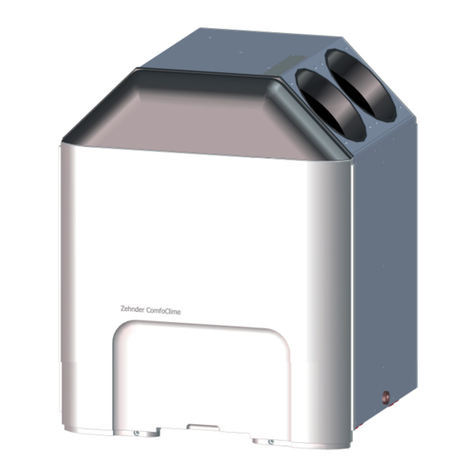
Zehnder Rittling
Zehnder Rittling ComfoClime 24 Installer manual

ClimateMaster
ClimateMaster 803 series Installation, operation and maintanance manual
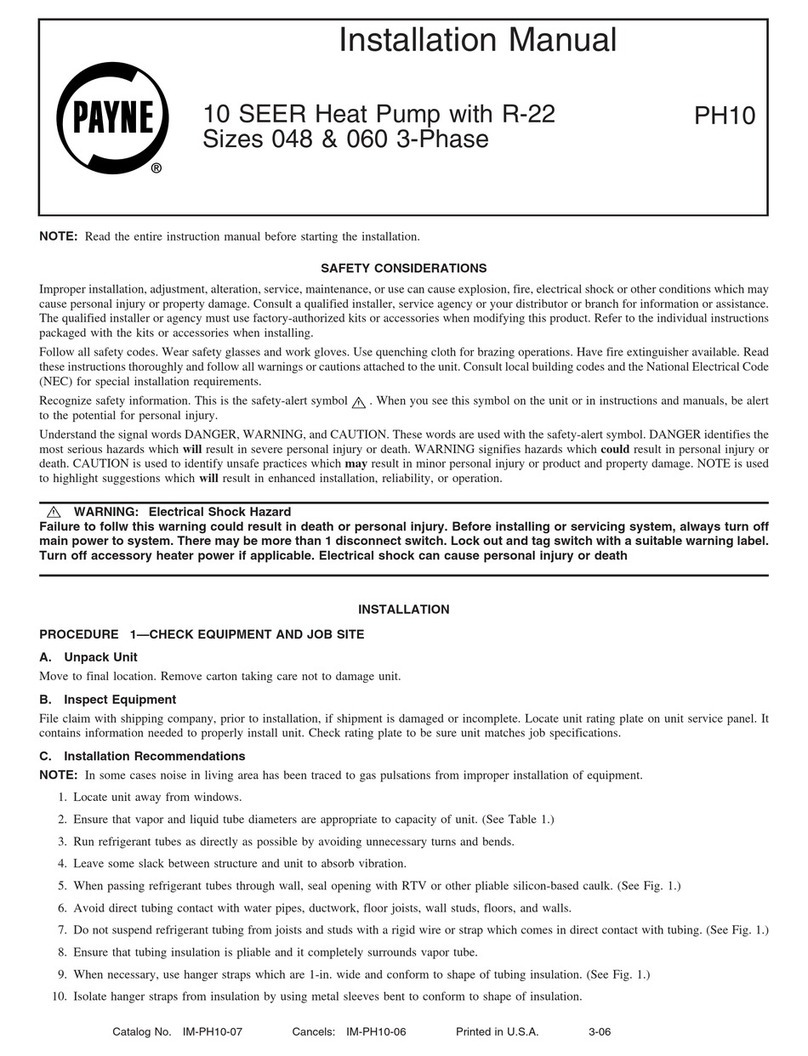
Payne
Payne PH10 installation manual
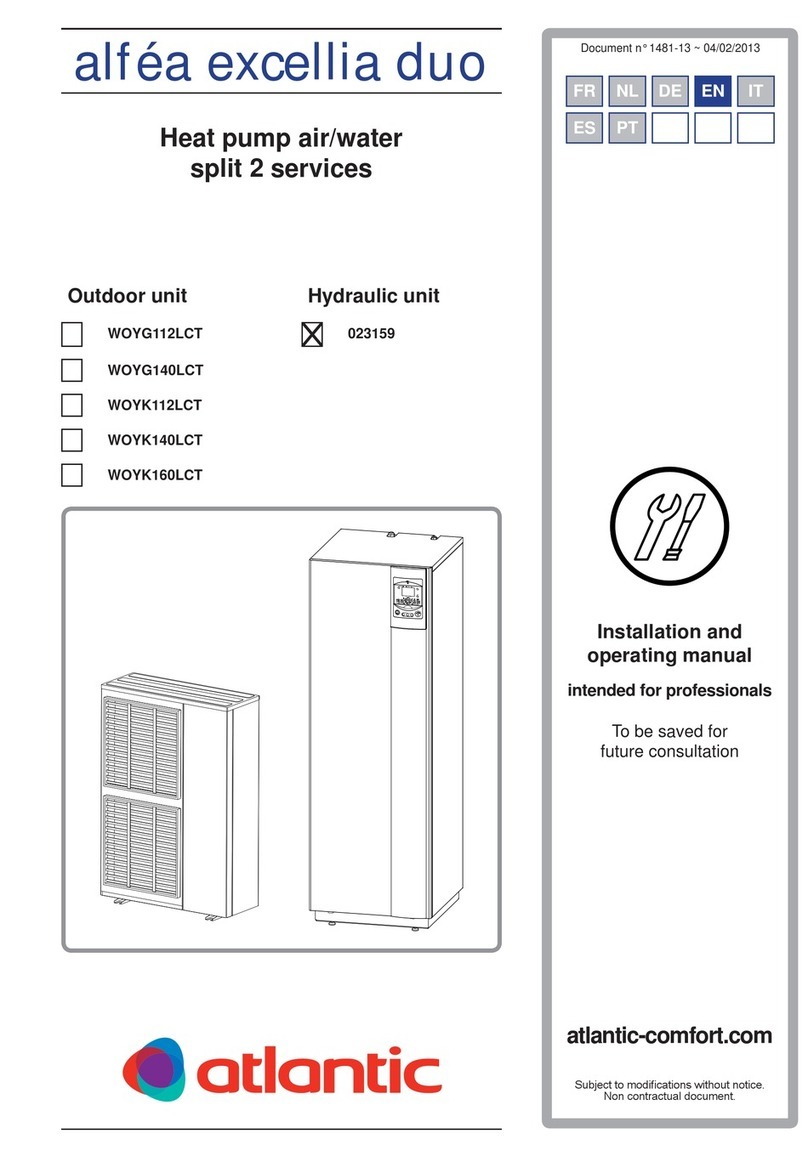
Atlantic
Atlantic 023159 Installation and operating manual
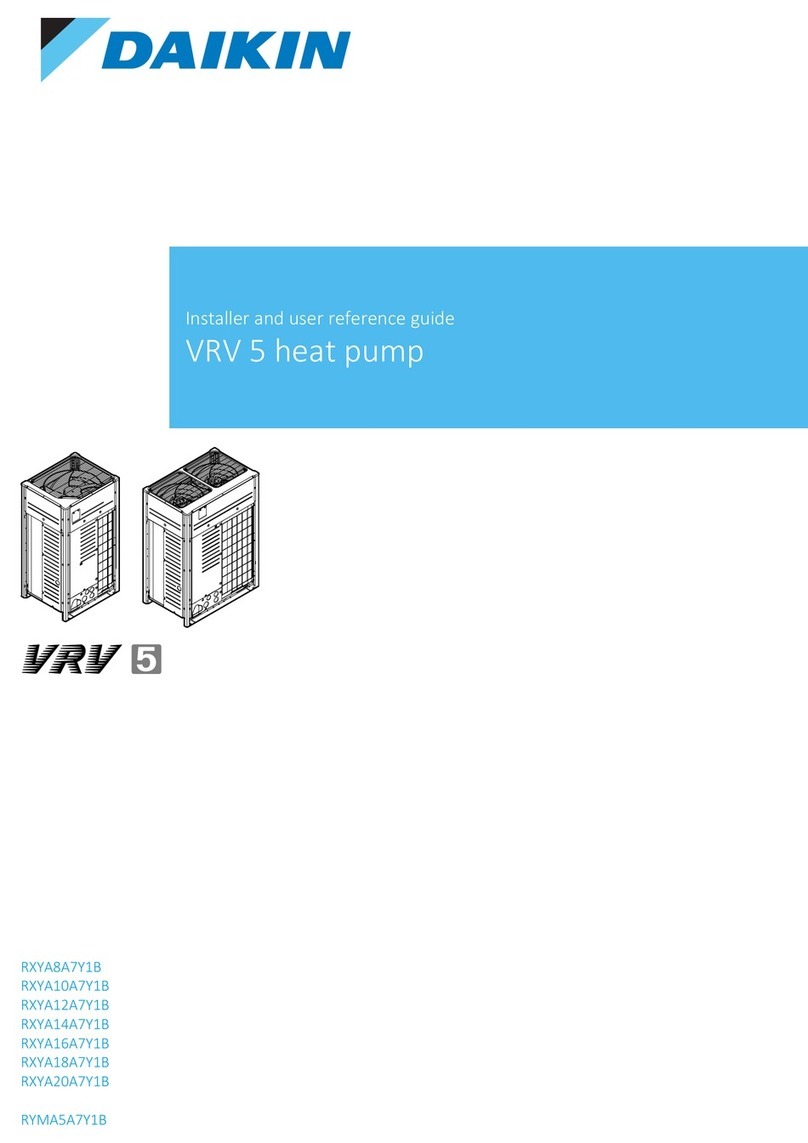
Daikin
Daikin VRV 5 RXYA8A7Y1B Installer and user guide
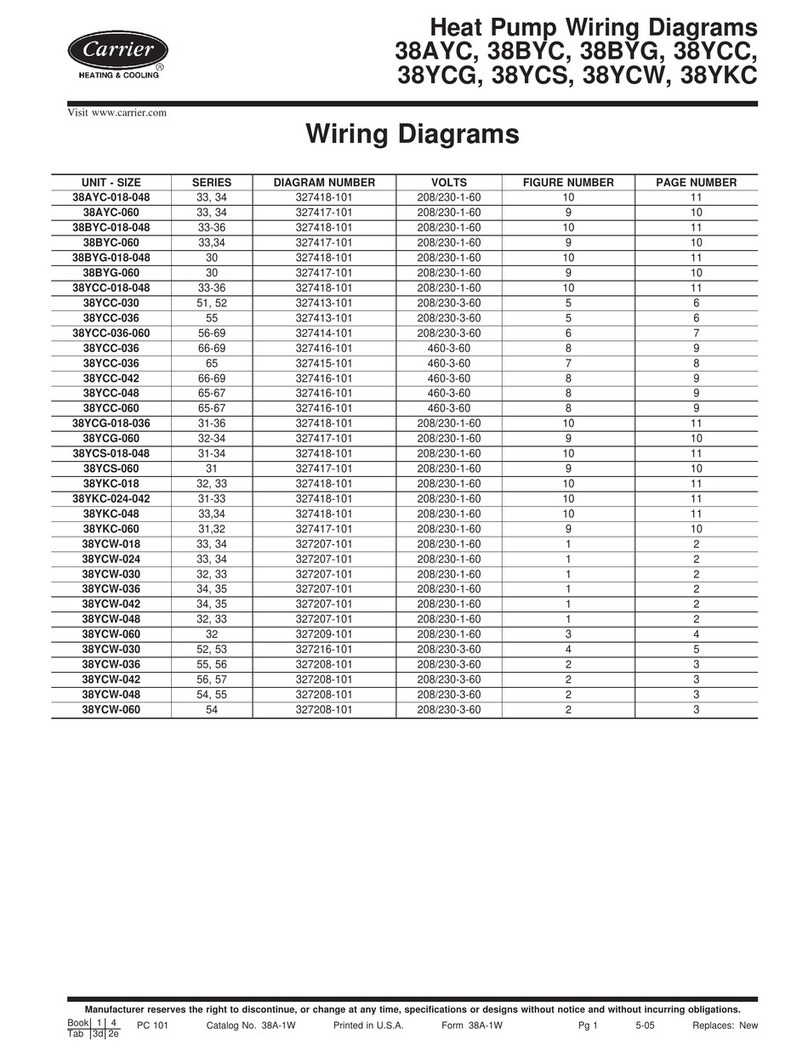
Carrier
Carrier 38AYC Series Wiring diagrams

